[English] 日本語
 Yorodumi
Yorodumi- PDB-3qi9: Crystal structure of mouse CD1d-alpha-phosphotidylinositol with m... -
+ Open data
Open data
- Basic information
Basic information
| Entry | Database: PDB / ID: 3qi9 | |||||||||
|---|---|---|---|---|---|---|---|---|---|---|
| Title | Crystal structure of mouse CD1d-alpha-phosphotidylinositol with mouse Valpha14-Vbeta6 2A3-D NKT TCR | |||||||||
 Components Components |
| |||||||||
 Keywords Keywords | IMMUNE SYSTEM / autoreactivity / T-cell surface | |||||||||
| Function / homology |  Function and homology information Function and homology informationregulation of immature T cell proliferation in thymus / positive regulation of NK T cell activation / positive regulation of NK T cell differentiation / NK T cell differentiation / endogenous lipid antigen binding / antigen processing and presentation, exogenous lipid antigen via MHC class Ib / positive thymic T cell selection / positive regulation of macrophage activation / Endosomal/Vacuolar pathway / DAP12 interactions ...regulation of immature T cell proliferation in thymus / positive regulation of NK T cell activation / positive regulation of NK T cell differentiation / NK T cell differentiation / endogenous lipid antigen binding / antigen processing and presentation, exogenous lipid antigen via MHC class Ib / positive thymic T cell selection / positive regulation of macrophage activation / Endosomal/Vacuolar pathway / DAP12 interactions / Antigen Presentation: Folding, assembly and peptide loading of class I MHC / ER-Phagosome pathway / DAP12 signaling / Immunoregulatory interactions between a Lymphoid and a non-Lymphoid cell / antigen processing and presentation / positive regulation of interleukin-4 production / regulation of immune response / cellular defense response / T cell receptor binding / Neutrophil degranulation / positive regulation of interleukin-2 production / cellular response to iron(III) ion / iron ion transport / negative regulation of forebrain neuron differentiation / antigen processing and presentation of exogenous protein antigen via MHC class Ib, TAP-dependent / peptide antigen assembly with MHC class I protein complex / regulation of iron ion transport / regulation of erythrocyte differentiation / HFE-transferrin receptor complex / response to molecule of bacterial origin / MHC class I peptide loading complex / T cell mediated cytotoxicity / positive regulation of T cell cytokine production / antigen processing and presentation of endogenous peptide antigen via MHC class I / MHC class I protein complex / negative regulation of neurogenesis / positive regulation of receptor-mediated endocytosis / cellular response to nicotine / positive regulation of T cell mediated cytotoxicity / multicellular organismal-level iron ion homeostasis / positive regulation of type II interferon production / phagocytic vesicle membrane / negative regulation of epithelial cell proliferation / sensory perception of smell / positive regulation of cellular senescence / late endosome / T cell differentiation in thymus / negative regulation of neuron projection development / protein refolding / protein homotetramerization / amyloid fibril formation / intracellular iron ion homeostasis / learning or memory / early endosome / lysosome / endosome membrane / innate immune response / lysosomal membrane / external side of plasma membrane / structural molecule activity / Golgi apparatus / protein homodimerization activity / extracellular space / cytosol Similarity search - Function | |||||||||
| Biological species |  | |||||||||
| Method |  X-RAY DIFFRACTION / X-RAY DIFFRACTION /  SYNCHROTRON / SYNCHROTRON /  MOLECULAR REPLACEMENT / MOLECULAR REPLACEMENT /  molecular replacement / Resolution: 2.3 Å molecular replacement / Resolution: 2.3 Å | |||||||||
 Authors Authors | Clarke, A.J. / Rossjohn, J. | |||||||||
 Citation Citation |  Journal: Immunity / Year: 2011 Journal: Immunity / Year: 2011Title: A molecular basis for NKT cell recognition of CD1d-self-antigen Authors: Mallevaey, T. / Clarke, A.J. / Scott-Browne, J.P. / Young, M.H. / Roisman, L.C. / Pellicci, D.G. / Patel, O. / Vivian, J.P. / Matsuda, J.L. / McCluskey, J. / Godfrey, D.I. / Marrack, P. / ...Authors: Mallevaey, T. / Clarke, A.J. / Scott-Browne, J.P. / Young, M.H. / Roisman, L.C. / Pellicci, D.G. / Patel, O. / Vivian, J.P. / Matsuda, J.L. / McCluskey, J. / Godfrey, D.I. / Marrack, P. / Rossjohn, J. / Gapin, L. | |||||||||
| History |
|
- Structure visualization
Structure visualization
| Structure viewer | Molecule:  Molmil Molmil Jmol/JSmol Jmol/JSmol |
|---|
- Downloads & links
Downloads & links
- Download
Download
| PDBx/mmCIF format |  3qi9.cif.gz 3qi9.cif.gz | 188 KB | Display |  PDBx/mmCIF format PDBx/mmCIF format |
|---|---|---|---|---|
| PDB format |  pdb3qi9.ent.gz pdb3qi9.ent.gz | 145.2 KB | Display |  PDB format PDB format |
| PDBx/mmJSON format |  3qi9.json.gz 3qi9.json.gz | Tree view |  PDBx/mmJSON format PDBx/mmJSON format | |
| Others |  Other downloads Other downloads |
-Validation report
| Summary document |  3qi9_validation.pdf.gz 3qi9_validation.pdf.gz | 1 MB | Display |  wwPDB validaton report wwPDB validaton report |
|---|---|---|---|---|
| Full document |  3qi9_full_validation.pdf.gz 3qi9_full_validation.pdf.gz | 1 MB | Display | |
| Data in XML |  3qi9_validation.xml.gz 3qi9_validation.xml.gz | 36.1 KB | Display | |
| Data in CIF |  3qi9_validation.cif.gz 3qi9_validation.cif.gz | 48.7 KB | Display | |
| Arichive directory |  https://data.pdbj.org/pub/pdb/validation_reports/qi/3qi9 https://data.pdbj.org/pub/pdb/validation_reports/qi/3qi9 ftp://data.pdbj.org/pub/pdb/validation_reports/qi/3qi9 ftp://data.pdbj.org/pub/pdb/validation_reports/qi/3qi9 | HTTPS FTP |
-Related structure data
| Related structure data |  3au1C  3he7S S: Starting model for refinement C: citing same article ( |
|---|---|
| Similar structure data |
- Links
Links
- Assembly
Assembly
| Deposited unit | 
| ||||||||
|---|---|---|---|---|---|---|---|---|---|
| 1 |
| ||||||||
| Unit cell |
|
- Components
Components
-Protein , 4 types, 4 molecules ABCD
| #1: Protein | Mass: 34662.012 Da / Num. of mol.: 1 / Fragment: residues in UNP 19-297 Source method: isolated from a genetically manipulated source Source: (gene. exp.)   Trichoplusia ni (cabbage looper) / References: UniProt: P11609 Trichoplusia ni (cabbage looper) / References: UniProt: P11609 |
|---|---|
| #2: Protein | Mass: 11660.350 Da / Num. of mol.: 1 Source method: isolated from a genetically manipulated source Source: (gene. exp.)   Trichoplusia ni (cabbage looper) / References: UniProt: P01887 Trichoplusia ni (cabbage looper) / References: UniProt: P01887 |
| #3: Protein | Mass: 22779.180 Da / Num. of mol.: 1 Source method: isolated from a genetically manipulated source Details: chimera of Mouse variable domain and human constant domain Source: (gene. exp.)   |
| #4: Protein | Mass: 27322.561 Da / Num. of mol.: 1 Source method: isolated from a genetically manipulated source Details: chimera of Mouse variable domain and human constant domain Source: (gene. exp.)   |
-Sugars , 2 types, 3 molecules 
| #5: Polysaccharide | 2-acetamido-2-deoxy-beta-D-glucopyranose-(1-4)-2-acetamido-2-deoxy-beta-D-glucopyranose Source method: isolated from a genetically manipulated source |
|---|---|
| #6: Sugar |
-Non-polymers , 4 types, 184 molecules 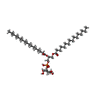






| #7: Chemical | ChemComp-PII / | ||
|---|---|---|---|
| #8: Chemical | ChemComp-MG / | ||
| #9: Chemical | | #10: Water | ChemComp-HOH / | |
-Details
| Has protein modification | Y |
|---|---|
| Sequence details | HIS A 201 IS FROM GENBANK DATABASE, BAB22206. ALA B 85 IS NATURAL VARIANT. |
-Experimental details
-Experiment
| Experiment | Method:  X-RAY DIFFRACTION / Number of used crystals: 1 X-RAY DIFFRACTION / Number of used crystals: 1 |
|---|
- Sample preparation
Sample preparation
| Crystal | Density Matthews: 3.44 Å3/Da / Density % sol: 64.24 % |
|---|---|
| Crystal grow | Temperature: 296 K / Method: vapor diffusion, hanging drop / pH: 6.2 Details: PEG 6000, Sodium Citrate, pH 6.2, VAPOR DIFFUSION, HANGING DROP, temperature 296K |
-Data collection
| Diffraction source | Source:  SYNCHROTRON / Site: SYNCHROTRON / Site:  Australian Synchrotron Australian Synchrotron  / Beamline: MX2 / Wavelength: 1.47 Å / Beamline: MX2 / Wavelength: 1.47 Å |
|---|---|
| Radiation | Protocol: SINGLE WAVELENGTH / Monochromatic (M) / Laue (L): M / Scattering type: x-ray |
| Radiation wavelength | Wavelength: 1.47 Å / Relative weight: 1 |
| Reflection | Resolution: 2.3→41 Å / Num. obs: 69852 / Redundancy: 13.3 % / Net I/σ(I): 15.3 |
-Phasing
| Phasing | Method:  molecular replacement molecular replacement |
|---|
- Processing
Processing
| Software |
| |||||||||||||||||||||||||||||||||||||||||||||
|---|---|---|---|---|---|---|---|---|---|---|---|---|---|---|---|---|---|---|---|---|---|---|---|---|---|---|---|---|---|---|---|---|---|---|---|---|---|---|---|---|---|---|---|---|---|---|
| Refinement | Method to determine structure:  MOLECULAR REPLACEMENT MOLECULAR REPLACEMENTStarting model: 3HE7 Resolution: 2.3→39.31 Å / Cor.coef. Fo:Fc: 0.93 / Cor.coef. Fo:Fc free: 0.914 / Occupancy max: 1 / Occupancy min: 0 / SU B: 7.969 / SU ML: 0.19 / Cross valid method: THROUGHOUT / σ(F): 0 / ESU R: 0.274 / ESU R Free: 0.222 / Stereochemistry target values: MAXIMUM LIKELIHOOD Details: HYDROGENS HAVE BEEN USED IF PRESENT IN THE INPUT U VALUES: REFINED INDIVIDUALLY
| |||||||||||||||||||||||||||||||||||||||||||||
| Solvent computation | Ion probe radii: 0.8 Å / Shrinkage radii: 0.8 Å / VDW probe radii: 1.2 Å / Solvent model: MASK | |||||||||||||||||||||||||||||||||||||||||||||
| Displacement parameters | Biso max: 124.15 Å2 / Biso mean: 54.3635 Å2 / Biso min: 24.68 Å2
| |||||||||||||||||||||||||||||||||||||||||||||
| Refinement step | Cycle: LAST / Resolution: 2.3→39.31 Å
| |||||||||||||||||||||||||||||||||||||||||||||
| Refine LS restraints |
| |||||||||||||||||||||||||||||||||||||||||||||
| LS refinement shell | Resolution: 2.3→2.36 Å / Total num. of bins used: 20
|
 Movie
Movie Controller
Controller


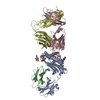
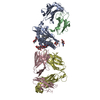
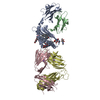
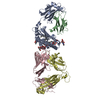
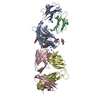


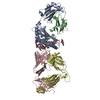
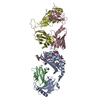

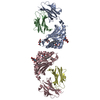
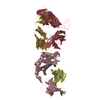
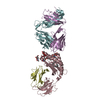
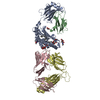
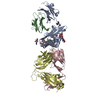

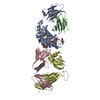

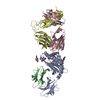
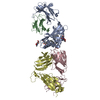
 PDBj
PDBj













